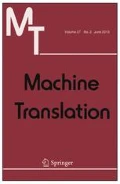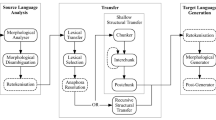Abstract
This paper reviews the OpenLogos rule-based machine translation system, and describes its model architecture as an incremental pipeline process. The paper also describes OpenLogos resources and their customization to specific application domains. One of the key aspects of rule-based machine translation systems intelligence is the symbology employed by these systems in representing natural language internally. The paper offers details about the OpenLogos semantico-syntactic abstract representation language known as SAL. The paper also shows how OpenLogos has addressed classic problems of rule-based machine translation, such as the cognitive complexity and ambiguity encountered in natural language processing, illustrating how SAL helps overcome them in ways distinct from other existing rule-based machine translation systems. The paper illustrates how the intelligence inherent in SAL contributes to translation quality, presenting examples of OpenLogos output of a kind that non-linguistic systems would likely have difficulty emulating. The paper shows the unique manner in which OpenLogos applies the rulebase to the input stream and the kind of results produced that are characteristic of the OpenLogos output. Finally, the paper deals with an important advantage of rule-based machine translation systems, namely, the customization and adaption to application-specific needs with respect to their special terminology and transfer requirements. OpenLogos offers users a set of comfortable customization tools that do not require special knowledge of the system internals. An overview of the possibilities that these tools provide will be presented.
Similar content being viewed by others
References
Barreiro A (2008a) Port4NooJ: Portuguese linguistic module and bilingual resources for machine translation. In: Blanco X, Silberztein M (eds) Proceedings of the 2007 International NooJ Conference June 7–9, 2007, Cambridge Scholars Publishing, Barcelona, Spain, pp 19–47
Barreiro A (2008b) Make it simple with paraphrases. Automated paraphrasing for authoring aids and machine translation. PhD dissertation. Universidade do Porto, Portugal
Barreiro A (2008c) ParaMT: a paraphraser for machine translation. In: Teixeira A, Strube de Lima VL, de Oliveira LC, Quaresma P (eds) Computational processing of the Portuguese language, 8th International conference, Proceedings (PROPOR 2008) vol. 5190, (8–10 de Setembro de 2008), Lecture Notes in Computer Science, Springer Verlag, Aveiro, Portugal, pp 202–211. ISSN: (Print) 1611-3349 (Online)
Barreiro A (2011) SPIDER: a system for paraphrasing in documente editing and revision: applicability in machine translation pre-editing. Computational linguistics and intelligent text processing. Proceedings of the 12th CICLing International Conference 6609 (2011), Part II, Lecture Notes in Computer Science, Springer, pp. 365–376. ISSN: 0302-9743. e-ISSN: 1611-3349. doi:10.1007/978-3-642-19400-9.
Barreiro A, Cabral LM (2009) ReEscreve: a translator-friendly multi-purpose paraphrasing software tool. In: Goulet M-J, Melançon C, Désilets A, Macklovitch E (eds) Proceedings of the Workshop Beyond Translation Memories: New Tools for Translators, The Twelfth Machine Translation Summit Château Laurier, Ottawa, ON Canada, pp 1–8
Chaudhury S, Rao A, Sharma DM (2010) Anusaaraka: an expert system based nachine translation system. In: Proceedings of 2010 IEEE International Conference on Natural Language Processing and Knowledge Engineering (IEEE NLP-KE2010), Beijing, China
Maia B, Matos S (2008) Corpógrafo V4: tools for researchers and teachers using comparable corpora. In Pierre Z, Éric G, Pascale F (eds), LREC 2008 Workshop on Comparable Corpora (LREC 2008), European Language Resources Association (ELRA), Marrakech, pp 79–82
Pierce JR, Carroll JB et al (1966) Language and machines: computers in translation and linguistics. ALPAC report, National Academy of Sciences, National Research Council, Washington.
Scott B, Barreiro A (2009) OpenLogos MT and the SAL representation language. In: Pérez-Ortiz JA, Sánchez-Martínez F, Tyers FM (eds) Proceedings of the First International Workshop on Free/Open-Source Rule-Based Machine Translation, Alicante, Spain, pp 19–26
Scott B (2003) The Logos model: an historical perspective. In: Machine Translation 18:1–72
Scott B (1997) Linguistic and computational motivations for the Logos machine translation system. http://logossystemarchives.homestead.com
Silberztein M (2007) An alternative approach to tagging. Invited Paper. In: Proceedings of NLDB 2007. LNCS series, Springer-Verlag, Berlin, Heidelberg, pp 1–11
Author information
Authors and Affiliations
Corresponding author
Rights and permissions
About this article
Cite this article
Barreiro, A., Scott, B., Kasper, W. et al. OpenLogos machine translation: philosophy, model, resources and customization. Machine Translation 25, 107–126 (2011). https://doi.org/10.1007/s10590-011-9091-z
Received:
Accepted:
Published:
Issue Date:
DOI: https://doi.org/10.1007/s10590-011-9091-z




